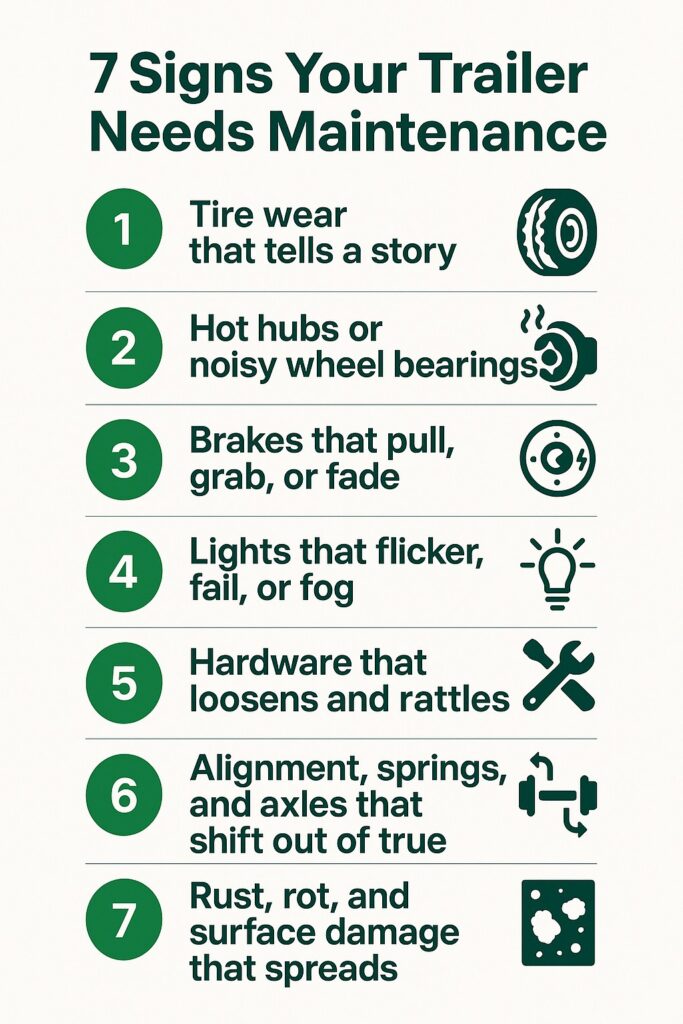Your rig earns money only when it rolls. Smart trailer maintenance keeps loads moving, protects your crew, and cuts repair costs. You do not need a full shop to spot trouble early. You need a sharp eye, a short checklist, and a plan you follow on every trip.
Use this guide to find the seven warning signs that call for action. Each sign points to specific parts to check and simple fixes you can handle. When you catch problems early, you avoid roadside delays and save your budget for growth instead of emergency work.
A quick routine that saves your day
Start every haul with a two-minute walkaround. Check your trailer from tongue to tail. Touch the tires. Glance at the springs and axles. Look at the lights.
Test the brake system and confirm the coupler on the hitch ball. This routine makes minor flaws obvious before they become big bills.
Keep your owner’s manual in the truck. Mark pages for wheel bearings, brakes, tire specs, and torque values. Most manufacturers call for a full service around 12,000 miles, but you control the schedule with your use case and terrain.
Sign 1: Tire wear that tells a story
Your trailer tires speak first. Uneven tread, feathering, and cupping tell you where to look.
If the outer shoulders wear fast, you may run low pressure or overload that axle. If the center wears fast, you likely put too much pressure. If one tire scrubs smoothly while the tire across from it looks fine, you may have bent axles or a misaligned spindle.
Run your palm across the tread ribs. If the tread feels like a saw blade, the wheel may wobble because of loose bearings or a worn hub. If the tread cups in a repeating pattern, look at worn shocks or a weak spring pack on that side.
Action steps:
- Check tire pressure cold before every trip. Use a gauge you trust.
- Check the tire tread with a depth tool. Replace tires that drop below safe limits.
- Spin each wheel by hand with the trailer lifted. Listen for scraping or grinding.
- Confirm torque on every lug nut. Recheck after the first 50 miles on new wheels.
If the pattern points to overheight or overweight loads on a given trailer, consider a different platform that fits that freight profile. If your loads often run tall but legal, a Step Deck Trailer can improve stability and reduce stress on axles. For legal height freight that needs fast side access, a Flatbed Trailer keeps turns tight and loading quick.
Sign 2: Hot hubs or noisy wheel bearings
Wheel ends carry huge forces. Heat and noise warn you before failure.
After a short run, place your hand near each hub. Warm hubs show standard friction. Very hot hubs point to tight wheel bearings, a dragging brake, or a dry wheel hub that needs grease.
Do not burn your hand. Use an infrared thermometer if you have one.
Jack the trailer and rock the wheel at the 12 and 6 o’clock points. Any play that you can feel deserves attention.
Spin the wheel. A healthy bearing turns smooth and quiet. A dry bearing growls, a pitted race clicks. Replace parts before they fail on the road.
Action steps:
- Follow your owner’s manual for service intervals. Many teams repack bearings every 12,000 miles or at least once a year.
- Use the proper grease for your environment. Marine grease helps boat trailers that face constant water exposure.
- Replace worn seals that leak. Keep water out and grease in.
Bearings cost little compared to the cost of a roadside failure. You control this risk with routine checks and clean lube.
Sign 3: Brakes that pull, grab, or fade
Your trailer brakes protect the whole combination. If the brake system pulls to one side, you likely have a seized magnet, a sticky caliper, or a contaminated shoe. If the brakes grab and release in a pulse, look for warped drums or rotors. If you need more pedal than usual, you may have air in the hydraulic lines or poor electrical power to the brake magnets.
Action steps:
- Test brake function on a safe, empty stretch. Apply the trailer only with the controller. Note any pull, pulse, or delay.
- Inspect magnets, shoes, pads, and drums. Replace worn parts as sets across the axle.
- Clean and protect connectors. Corrosion at plugs and grounds weakens power and causes uneven braking.
- Adjust brakes per the manual. Confirm equal current draw for electric brakes.
If you haul heavy equipment often, you ask more from your brakes. Upgrade friction material, magnets, and wiring to match that duty cycle. Stop issues early before they cause tire flat spots or bearing heat.
Sign 4: Lights that flicker, fail, or fog
Your trailer lights do more than meet the law. They keep your crew visible when rain, dust, or darkness reduces sight lines.
Flicker and random failure point to poor grounds or chafed wires. Water inside the housing shows a seal issue. Boat trailers face this all the time.
Action steps:
- Clean every ground point down to bright metal. Coat with dielectric grease to prevent corrosion.
- Inspect the harness along the frame. Fix rub points with loom and clamps.
- Replace cracked lenses and weak gaskets. Water fogs the lens and kills bulbs and boards.
- Test hazard, brake, turn, and marker circuits before every run.
Clear, bright lights cut risk at night and in bad weather. You keep them healthy with clean grounds and dry housing.
Sign 5: Hardware that loosens and rattles
Vibration loosens fasteners. You can hear this sign before you see it. Rattles from the tongue, the deck, or the gate shorten hardware life and stress welds.
Action steps:
- Check torque on every lug nut and key frame bolt. Mark them with paint to track movement.
- Inspect the coupler and verify clean latch action on the hitch ball. Replace a worn coupler that rocks on the ball.
- Inspect safety chains, hooks, and pins. Replace bent or stretched links.
- Tighten stake pockets, D-rings, winch bases, and ramp pins.
Do not ignore small rattles. They grow into fatigue cracks and lost parts. Secure hardware protects cargo and preserves the frame.
Sign 6: Alignment, springs, and axles that shift out of true
The running gear tells the truth about load patterns. Look under the deck if you fight sway, wander, or sudden bounce. Springs sag over time.
Equalizers seize. Bushings crush and split. Those changes shift axle alignment and geometry.
Action steps:
- Sight down the side profile of each spring pack. Look for a weak or reversed arch.
- Inspect shackle bushings and equalizers. Replace parts that show oval holes or crushed sleeves.
- Measure from the coupler to each axle end. The measurements should match side to side. You may have a shifted hanger or bent axles if they do not.
- Confirm ride height and load balance. Move cargo to center the mass over the axle group.
A healthy suspension tracks straight, keeps tires flat on the road, and slows wear on every component. Fix alignment early, and your trailer tires will thank you.
Sign 7: Rust, rot, and surface damage that spreads
You cannot stop time, but you can slow decay. Rust, corrosion, and rot attack frames, decks, and fasteners. Water, salt, and road film speed that attack. Small spots turn into structural concerns when you ignore them.
Action steps:
- Wash the frame and underbody often. Use a foam pre-soak after winter trips. Rinse thoroughly.
- Dry and coat exposed steel with primer and paint. Use zinc-rich coatings on high-risk zones.
- Aluminum decks and frames use clean road film and dissimilar metal contact points. Mixed metals cause galvanic attack.
- Seal wood decks and replace cracked boards. Standing water and UV beat up boards fast.
Clean hardware lasts, frames resist cracks, and lights stay bright. You cannot control the weather, but you can control how your trailer faces it.

Bonus checks that protect every load
Hubs and seals. Look for grease slings on the inside of the wheels. Replace torn seals. Keep dirt out of the hub.
Chains and binders. Inspect hooks, grab points, and binders for stretch or nicks. Replace chains that no longer match their stamped rating.
Ramps. Test hinge pins and latch pins. Confirm that the ramp face grips as designed. Wet steel ramps can send equipment off course.
Doors and curtains. Inspect hinges, rollers, and locks. Keep tracks clean and lubed. A sticky door wastes time at delivery.
Tongue jack. Keep the screw clean and greased. Confirm the foot plate sits flat and locks in place.
Build a simple maintenance schedule
Write a plan that fits your routes and seasons. Keep the language short and direct. Post it where the team can see it.
Every trip:
- Walkaround and light test.
- Tire pressure and tread glance.
- Coupler, hitch ball, chains, and plug.
Every month:
- Full light function test.
- Brake controller test and gain check.
- Suspension visual check.
- Regular maintenance.
Every quarter:
- Torque check on wheels and key fasteners.
- Harness inspection and loom repair.
- Deck and frame wash and protective coat.
Every 12,000 miles or annually:
- Wheel bearings inspection and repack.
- Complete brake system service.
- Alignment and axle measurement.
- Tire rotation if the pattern allows it.
You can adjust these intervals when you haul heavy loads in heat, on grades, or on rough roads. Trailer owners who run heavy in summer often shorten the cycle to keep wheel ends cool and hubs tight.
When to repair and when to upgrade
Some trailers reach a point where parts stack up and downtime grows. If you see repeated hub issues, constant tire wear, and a deck that no longer fits your freight mix, do the math. Newer platforms save time at docks and cut stress on the brake system and running gear.
If you haul legal-height freight and want fast loading with forklifts, review our Flatbed Trailer options. If your loads run tall and you want a lower deck for stability and clearance, compare our Step Deck Trailer models. The right platform often reduces maintenance by matching the job better than a quick fix.
A short pre-trip script for every driver
You can train any driver to check your trailer the same way every time. Use this script at the lot.
- Verify the coupler on the hitch ball. Lock the latch. Insert the safety pin. Connect both safety chains.
- Plug in the harness. Test all trailer lights. Clean the ground if a light fails.
- Check tire pressure with a gauge. Inspect tread and sidewalls. Look for nails or cuts.
- Spin a wheel off the ground if time allows. Listen for rough bearings. Check for play.
- Set the brake controller. Test the trailer brakes at low speed. Confirm a straight, smooth stop.
- Inspect springs, equalizers, and hangers. Look for cracks, sag, or shiny rub marks.
- Scan the deck and frame. Tighten the loose gear. Remove debris, close and latch ramps or doors.
Don’t forget to log what you find. A simple notebook creates a record that helps you track patterns and plan parts orders before you need them.
The payoff from disciplined trailer maintenance
You work in real conditions. Rain. Dust. Heat. Tight docks. Heavy cycles.
A short list and a steady routine keep your operation sharp.
Clean hubs run cool. True axles track straight. Dry connectors light up every time: good tires grip and last. Strong brakes stop you with room to spare.
You protect your drivers when you keep the trailer honest. You protect your customers when loads arrive on time and in good condition. You protect your balance sheet when you fix minor flaws today instead of paying for big failures tomorrow.
If your checks reveal problems that come back repeatedly, you can move into a trailer that better fits your work. Explore a proven flatbed trailer for general freight and dock speed. Or shift to a step deck trailer for taller machines and a lower center of gravity. The right match reduces stress on hubs, tires, and brakes, and it sets your team up for long, reliable service.





